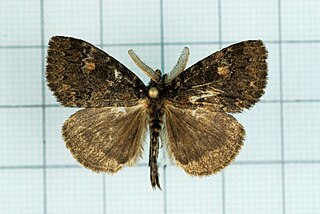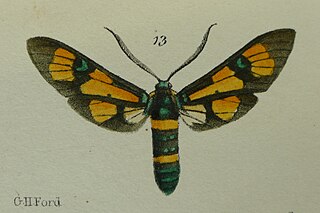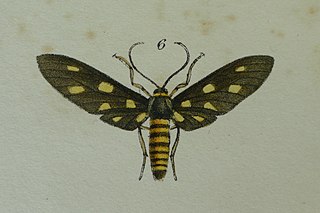
Brunia is a genus of tiger moths in the family Erebidae. The genus was described by Moore in 1878.
Nishada is a genus of moths in the family Erebidae. They are found in India, Sri Lanka, Myanmar, Sumatra, and Borneo.

Ugia is a genus of moths in the family Erebidae erected by Francis Walker in 1858.
Dunira is a genus of moths of the family Erebidae. The genus was described by Moore in 1885.

Egnasia is a genus of moths of the family Erebidae. The genus was first described by Francis Walker in 1859.

Hadennia is a genus of moths of the family Erebidae. The genus was described by Moore in 1885.

Ilema is a genus of tussock moths in the family Erebidae. The genus was described by Walker in 1855 and renamed by Moore in 1860, because Walker's chosen name was preoccupied.

Amata cantori is a moth in the genus Amata of the subfamily Arctiinae. The species was first described by Frederic Moore in 1859. It is found on Peninsular Malaysia and Borneo.

Seseria is an Indomalayan genus of spread-winged skippers in the family Hesperiidae.

Euchromia horsfieldi is a species of moth in the subfamily Arctiinae first described by Frederic Moore in 1859. It is found on Java, Sumatra, Borneo, the Lesser Sunda Islands and Christmas Island.

Amata wallacei is a species of moth in the family Erebidae first described by Frederic Moore in 1859. It is found on Java, Sumatra, Peninsular Malaysia and Borneo.
Katha prabana is a moth of the family Erebidae first described by Frederic Moore in 1859. It is found on the Sula Islands, Borneo, Sumatra, Java, Bali, Sulawesi, the Moluccas and in Myanmar. The habitat consists of lowland areas.
Nishada flabrifera is a moth of the family Erebidae. It is found in Sri Lanka, India and on Java.
Nishada chilomorpha is a moth of the family Erebidae first described by Snellen in 1877. It is found on Java and in Sundaland, the north-eastern Himalayas and Taiwan. The habitat consists of various lowland forest types, except heath forests. It is also found less frequently in lower montane forests.
Nishada rotundipennis is a moth of the family Erebidae first described by Francis Walker in 1862. It is found on Borneo and Peninsular Malaysia and in Myanmar and the north-eastern Himalayas. The habitat consists of forests.
Nishada syntomioides is a moth of the family Erebidae first described by Francis Walker in 1862. It is found on Borneo. The habitat consists of lowland forests.
Nishada melanistis is a moth of the family Erebidae first described by Charles Swinhoe in 1902. It is found on Borneo and Sulawesi.
Nishada tula is a moth of the family Erebidae first described by Charles Swinhoe in 1900. It is found on the Sula Islands in Indonesia.
Nishada xantholoma is a moth of the family Erebidae first described by Snellen in 1879. It is found on Sulawesi in Indonesia.
Spilarctia punctata is a moth in the family Erebidae. It was described by Frederic Moore in 1859. It is found in India in Myanmar and on Java and possibly Borneo.








